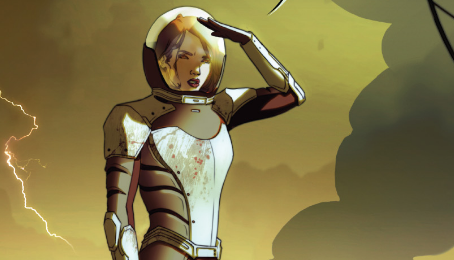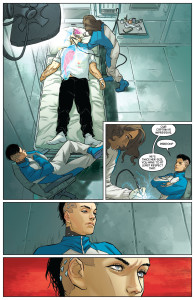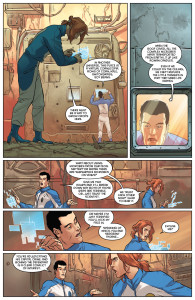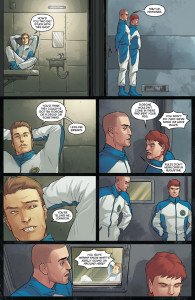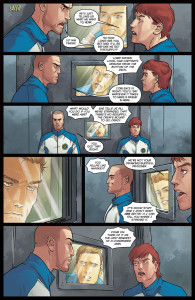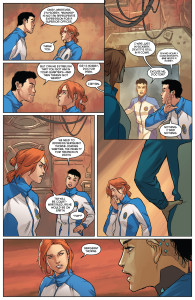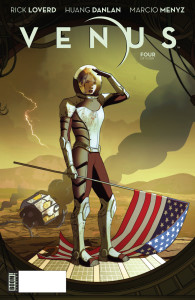 This week sees the final (for now…) issue of Venus hit comic shops and Comixology. Written by Rick Loverd, with art by Huang Danlan, Venus tells the story of the first human colonists on the second planet from the sun. The problem is…well, it’s Venus.
This week sees the final (for now…) issue of Venus hit comic shops and Comixology. Written by Rick Loverd, with art by Huang Danlan, Venus tells the story of the first human colonists on the second planet from the sun. The problem is…well, it’s Venus.
The series from Boom! Studios has been favorably compared to Andy Wier’s The Martian and for good reason – the science in the story is rooted in the real, something that should be no surprise given Loverd’s day job. When he’s not writing comic books, Loverd is the Program Director of The Science and Entertainment Exchange, a program of the National Academy of Sciences to match entertainment professionals with scientists and engineers in order to more accurately portray science in entertainment, and make the science that is shown more engaging to a wide audience. Enjoyed some science in a movie or television show recently? Loverd probably helped to facilitate it.
Let’s get into the science of Venus.
The Science Of: Rick, let’s start with a short bio – give us a bit of your background – who you are, and what you do…the short form.
Rick Loverd: I have (gasp) 15 years of entertainment industry experience including 2 years at a talent agency, 6 years working on TV shows, and 6 years in my current 9 to 5. I am the Program Director of The Science & Entertainment Exchange, a program of the National Academy of Sciences (NAS). The NAS is a private nonprofit institution with a mission to seek out and disseminate the very best nonpartisan peer reviewed science to the world.
In my role at NAS, my program has consulted on more than 1,400 mainstream film, TV, and video game projects since November of 2008. We do a good deal of work with Marvel, Warner Brothers, and Disney. A few highlights for us would be Iron Man 2, Thor, Tron: Legacy, Avengers: Age of Ultron, Star Trek: Into the Darkness, Man of Steel, Fringe, Castle, The Bourne Legacy, The Good Wife, Captain America: The Winter Soldier, Ant Man and Big Hero Six. I basically get to be in the room (or on the phone) with creative people and scientists every day, talking about the future and lots of other great nerdy stuff. It’s a fantastic nexus point to learn from the best in many fields.
TSO: While we’ll definitely be talking to you about the mission of The Science & Entertainment Exchange, let’s get on to your comic book series. How did this all lead to Venus?
RL: Well, bits and pieces of information cobbled together over time formed the spine of Venus. My big epiphany came when I heard NASA’s Jet Propulsion Lab’s (JPL) Deputy Chief Scientist for Solar System Exploration, Kevin Hand, speaking about planetary sciences at a small event in L.A. – you might notice that he wrote one letters Boom! included at the back of each issue of Venus. Dr. Hand mentioned as an aside that Venus and Earth were sister planets and may have had very similar climates a couple of billion years ago – that got me thinking. How did things go so wrong on Venus? Why is Venus more than 800 degrees on an normal day when earth hovers around 70? Could we find a way to bring Venus back to its balmy roots?
Filip Sablik, from Boom! and I are close friends and we like to share our creative ideas very informally. He and I started throwing around our thoughts and he really encouraged me to develop Venus into more than just a scribble in a notepad. Filip and I ended up fleshing out the world of Venus and all of its imperfect characters together. He and Stephen Christy ended up providing a ton of the encouragement that lead to the comic.
TSO: Given your day job, did you feel extra pressure to make sure you were getting all the science right?
RL: I felt a great deal of pressure to get the science right in this book. That said, I’m never trying to be the accuracy police in my interactions with Hollywood creative professionals. I’m happy to sacrifice documentary-style attention to real world detail for a good story – as long as we’re talking about narrative fiction.
So now’s the part where your readers point out all of the things that are implausible in Venus. I won’t go line by line and pick things apart. What I will say is that this book was lovingly crafted in the spirit of hard sci-fi, and an effort was made to be within the realm of plausibility wherever possible. Where I strayed from grounded ideas, I tried as much as I could to make a conscious decision to part with reality as opposed to just making something up blindly, without a real world understanding of the science.
TSO: You work to match scientists with other writers and creators. Who served as your personal brain trust for Venus?
RL: I met for many beers, had many phone calls, and late night text conversations with several scientists in the making of Venus. Notably, the aforementioned Kevin Hand, JPL’s Randii Wessen, The Bad Astronomer Phil Plait, Space Tourism Society’s John Spencer, and JPL’s Steve Vance. Now, I’m sure that none of them would vouch for the full accuracy of Venus, and would likely find a host of questionable science. This was part of the reason I requested that Boom! create a space in the book for scientists and science communicators to talk about the science of Venus.
Scientists and engineers are the true stars of our culture. These are the people who will actually get us to other planets and cure our worst ailments. If humanity solves its biggest problems before we manage to destroy ourselves, we’ll have scientists to thank. I wish we followed scientific discoveries with the same mainstream verve we bring to professional sports.
TSO: No argument from us on that last one. Sticking with the science, how much did you pull from current views of Venus, and how much did you have to extrapolate?
RL: I grounded the piece in current science, then sprinkled in the idea that our society will need to develop new and powerful technologies to combat climate change on earth in the next 100 years or so. In my world, Venus has been somewhat terraformed. The temperature is more like 200 degrees on an average day, pretty hot, but it’s not going to melt lead the way it would if you were on the surface right now. Also, our characters are on the tallest mountain on the planet, Maxwell Montes, which would likely have some of the coolest temperatures.
I’m told by my science cadre that my thinking is generally possible, however my timeline of terraforming a planet by 2150 may be dubious. To that I say, experts thought that mapping the human genome would take decades when it took years – who knows what human ingenuity will produce given nearly a century and a half. Imagine standing on a street corner in Manhattan in 1860 and trying to explain your iPad to a New Yorker. Your tablet would be indistinguishable from magic.
TSO: As we were talking – you wanted to keep things plausible rather than “documentary.” During the creation process, what was your comfort zone in terms of stretching the science?
RL: I give myself a fair amount of latitude when it comes to scientific grey areas. If it does not violate a natural law and your story takes place in the future, then the science is possible. The closer your touchpoint is to the boundaries of our current understanding of science, the better your sandbox is to build out great grounded ideas. What solutions might understanding the micro biome have for personalized medicine? Perhaps cures to certain forms of cancer. Possibly new treatments for a broad array of mental health issues. Who knows? There’s a story there.
TSO: Is extrapolating from science to project an easy-ish thing? For instance, if I want to know what technology will be like in say, 50 years…is it a linear path that I could follow with some certainty?
RL: I’d say prognosticators are mostly only remembered when their wild predictions are proven to be true. It’s a bit of a low risk, high reward endeavor.
That said, it’s not a linear path to the future, but an exponential one. I’ve no doubt that humanity will invent game changing tech in the coming decades that is very much off of our current radar. Of course, there will always be certain technologies like fusion energy, that seem tantalizingly close to our grasp yet continually vex our best scientists and engineers. It does seem relatively easy to imagine the next few steps we will take in robotics, genetics, medicine, AI, and commercialized space travel. Peering 10 to 20 years into the future, I’d say there’s good deal of low hanging fruit we can envision. Past that timeframe, to my thinking, anything that is possible is fair game.
If you rewind time to the early 80’s and look at what futurists (though I don’t think they used that word then) were predicting – most thought we’d have rocket packs and robot butlers, but nearly all completely missed the implications of an interconnected network of computers to commerce and low cost access to instant information, arguably the most impactful advance in human culture – the technology that allows us all to share video of a turtle humping a shoe. By looking backwards we can see that the future is uncertain, and likely to be much more thrilling and full of memes than we could ever imagine.
TSO: Let’s get back to the education side of things for a little bit – give us a brief primer on Venus – what’s it like if we’re looking to take a trip?
RL: Venus right now is more than 800 degrees Fahrenheit on average day with atmospheric pressure many times that on Earth, sulfuric acid rain, and winds that gust as fast as a NASCAR stock racer. If you were standing on the surface, you would melt and be crushed in short order, so I’d definitely be skeptical of anyone who invites you to invest in a nudist colony there.
There is, however a spot in the atmosphere of Venus that is not greatly different from Earth’s in terms of pressure. So the idea of building a scientific outpost that would hover high in the sky, without having to make any changes to the planet is, to my understanding, plausible. Keeping it operating there would be a heck of an engineering problem.
TSO: It seems hard to tell a story about the colonization of Venus without the planet itself becoming a character – more specifically, an antagonist, at least from the reader’s point of view. Is that a safe explanation of how Venus operates in the story?
RL: 100%. Venus is an extraordinarily harsh environment, with so many ways to kill you. Like Antarctica, one can imagine hidden crevasses, lava flows, the possibility of an active crust, storms that rain acid. Mother nature did not intend for Venus to be a human sanctuary, and real estate prices will need to spike into the stratosphere on Earth in order for a permanent colony there to seem like a good idea. The specter of the landscape intervening to bump off or maim a character at an inopportune moment will always cast a shadow over the action.
TSO: Was your research done completely before you started the writing, or was it ongoing, and perhaps throwing monkey wrenches at your ideas as you went along?
RL: My research is always ongoing as I work, and Venus was no exception. My favorite moment came on a late night call with JPL’s Dr. Randii Wessen, when I asked him about jumping off a cliff on Venus. I knew that the pressure would start low at the top of the cliff and increase as my character got closer to the planet’s surface. I asked him if there would be a point when my jumper would just stop in mid air. He laughed at me. Working with scientists can at times be a humbling experience.
TSO: Well then, let’s talk about Venus’ surface – 90 atmospheres of pressure and 450°C. At those conditions, what would humans need to survive?
RL: The answer, as far as I know, is that humans would need to change those conditions in order to survive. Venus today would melt and/or crush, just about any useful building materials. Without terraforming, having a permanent home on the surface would be hard to accomplish. Of course, having said that, who knows what the building materials of the future may look like. There was a time, not to long ago, that aluminum was the most valuable metal on the planet and only very rich people could afford to have it – now we wrap our sandwiches in it and throw it away.
In the comic, we’ve reduced the pressure and temperature by scrubbing the atmosphere of many of the most potent greenhouse gasses.
TSO: You mentioned that your timeline for Venus’ partial terraforming is pretty optimistic for the real world, but can you give the timeline of Venus exploration and colonization that has happened before we pick up the series’ storyline?
RL: Next month, the Japanese Akatsuki probe should come online and send home a nice stream of data. From there, I can only hope that humanity invests vast sums of our tax dollars into space exploration. In this country, we currently budget less than half of one penny of each tax dollar to NASA. We need to do better than that, not only because there is an unfathomable wealth of learning that we could do in space, but also because the technology space exploration requires us to develop brings with it countless advancements that we can use to make our lives better here on Earth. Isn’t that worth a penny?
Anyway, our story opens at a point when a significant amount of terraforming has altered the Venetian landscape, however the conditions are still absolutely brutal by Earth standards. Pressure and temperature are much lower, on the order of one quarter of the current levels, however still roughly double the highest temperature ever recorded on this planet.
TSO: While we’re talking about the surface…one of the main events in issue #2 was the quake. What’s Venus’ seismic activity like? Is it enough to rule out underground habitats, as are occasionally suggested for Mars?
RL: Right – one idea that is being discussed by serious people is that we may build future Mars colonies in dormant lava tubes. Which works a lot better when your last earthquake happened about a million years ago, as is the case with the red planet. Data collected by the Magellan spacecraft suggests that Venus is an entirely seismically active with some regions that are absolutely lousy with faults. I’m not sure if anyone could say how big a Venusquake could get or with what frequency they occur, however that’s where I would argue we can let our imaginations be our guide for the purposes of a comic book series.
Also, it’s worth noting that a European orbiter took temperature readings of Venus that indicate the planet very likely has active volcanoes, so…stay tuned.
TSO: One of the other environmental visuals that stuck was the half-speed sulfuric acid rain. Can you explain that a little for the layperson?
RL: On Venus, you have precipitation made of sulfuric acid due largely to the runaway volcanism that over the eons has belched an unhealthy brew into the atmosphere. In the higher elevations, like the location of Camp Augustine on Maxwell Montes, that this would fall as snow or hail. Due to vastly high pressure, it’s also reasonable to postulate that it could fall much more slowly. This is all speculation, of course, based in real facts. However what a cool idea, and wouldn’t it be amazing to see if it does exist?
TSO: Cool would probably be subjective from the colonists’ eyes. But speaking of them, can you explain the colonization process? It was automated at the start, and then the humans came, right? What went into the camp location selection? It’s a real location on Venus, correct?
RL: Ishtar Terra, Maxwell Montes is completely real. It’s an enormous mountain on Venus. The reason I picked this location is because, just like an Earth mountain, it would have the thinnest atmosphere and some of the lowest temperatures. Robotic missions built camp Augustine before our story even begins. We open with the first human mission to Venus. This advanced team of scientists, engineers, and military personnel face the daunting task of preparing the colony for its eventual permanent residents.
TSO: What about the suits? How accurate are they for the environment they’d be exposed to?
RL: The suits would need to be pretty tough and constructed of advanced materials. With today’s technology, even in our more temperate fictional Venus climate, I can’t say that they would have the range of motion we see in what our characters wear, however materials science and nanotech have opened new doors we never thought possible. One can speculate that clothing in the future will be lighter weight, tougher, stronger, resistant to bacteria, and possibly self cleaning – what would be really great is if they could invent laundry that self-folded.
TSO: Very true – but given the environment, what happens to the person inside when a suit is breached?
RL: The pressure and temperature would kill you in no time at all. I’d imagine that your last cognizant sensation might be feeling your sweat and saliva boiling off of your body or perhaps your lungs loosing all of their oxygen as your bones compressed around your vital organs. It would certainly burn, and likely be painful, although not for very long.
TSO: Speaking of suits – can you give a little insight on Reyes? She seems to handle Venus’ climate just fine without a suit. What is…she?
RL: Reyes started as a human being. To call her post human or transhuman would be reasonable. She’s a soldier who has signed up for every syn-mod in the book in order to make herself stronger, faster, and add to her sensory inputs. She has the ability to interface directly with virtually any computer. Her skin and external tissue was replaced long ago with reinforced synthetics. You could certainly wonder how much of her is still human at this point.
TSO: We touched on this a little, but creatively, what happens when science doesn’t allow for the story you want to tell? Does the story change to match the science, or does the science get a little…pushed to the side in order for the story to survive?
RL: I guess that depends on how excited we all are about the story. Venus will always be a grounded sci-fi piece, so you’ll never see a unicorn popping in for a visit. Having said that, aliens are totally plausible to anyone who’s ever heard of The Drake Equation. I believe that within our lifetime we will find bacteria and other lifeforms on moons in our own solar system like Europa and Enceladus. So, alien life is grounded sci-fi in my opinion. Science for me as a writer opens me up to new possibilities much more than it limits my creative options, so pushing aside science in service of fancy doesn’t happen to me very often.
TSO: Of course, projecting science/technology is one thing, you also had to project out the world of 2150…political and social sciences are still sciences, so what went in to crating the geopolitical climate of Venus?
RL: The Venus comic assumes that sometime in the next century, the first mining colonies will be on Mars and that there will be at least one city on the moon. Asia already produces more PhDs than the United States and I see no reason why that unfortunate trend and others like it won’t continue. As long as we gut our educational system at the expense of future generations, it seems very plausible that America will not necessarily benefit from the most profitable space mining colonies of our asteroid belt, where it’s said that there are deposits of pure platinum and rare Earths the size of Texas. This series serves as a cautionary tale in which The United States has fallen behind due to our own self-inflicted wounds accrued over the next hundred and fifty years. I hope that western powers will not fall behind in space exploration, as they have in Venus, however it’s easy to envision our continued decline unless our culture changes course and does more to incentivize and encourage young people to pursue the science, technology, engineering, and math careers that will sustain and improve our way of life for future generations.
TSO: Your final issue hits comic shops and Comixology this week, and not to give too much away – things have been wildly changing as your story has unfolded. By the end of issue #3, it felt like we’re watching a movie that in no way can end in the next say, half hour…any hints as to how things are going to wrap up?
RL: Ha! Venus has many secrets to reveal, and I hope we get to explore all of them even beyond this four book series – wait until you find out all of the crazy chaos that’s been happening back on Earth – but what’s the fun in giving it all away? If you’ve read book two, then you know there’s a war back home and that our friends on Augustine have been cut off from their supply lines. It looks as though they’re really going to have to fight every day to keep from dying horribly.
And by the way, don’t get too attached to anyone.
Related:


